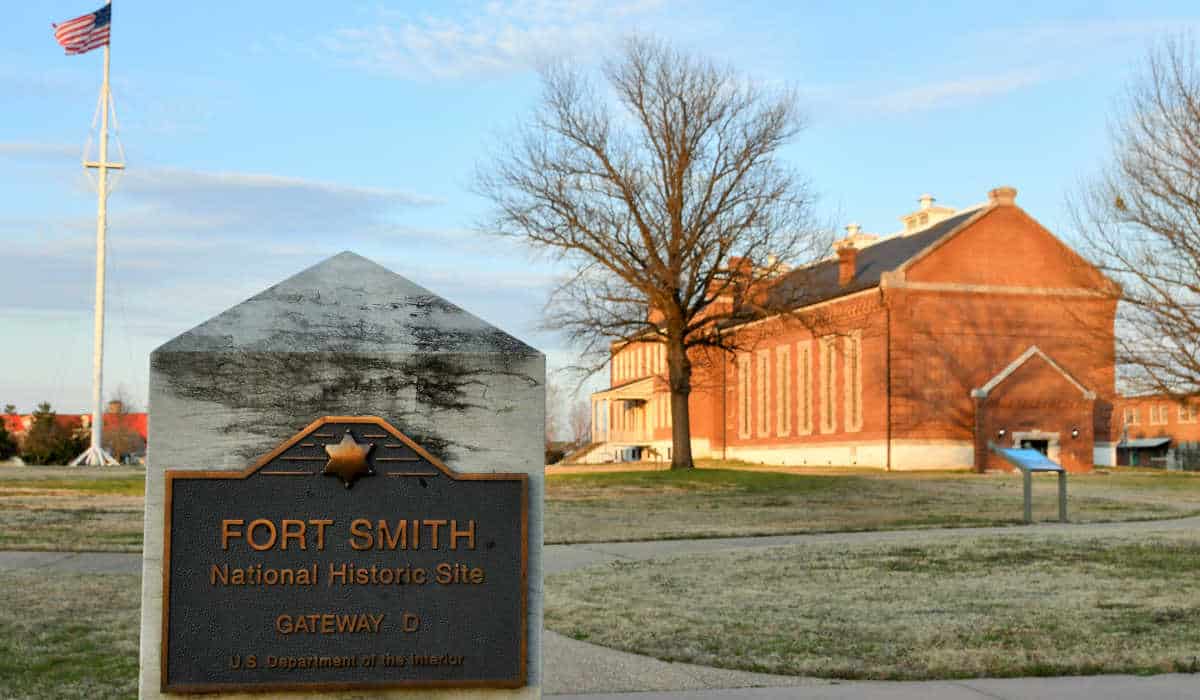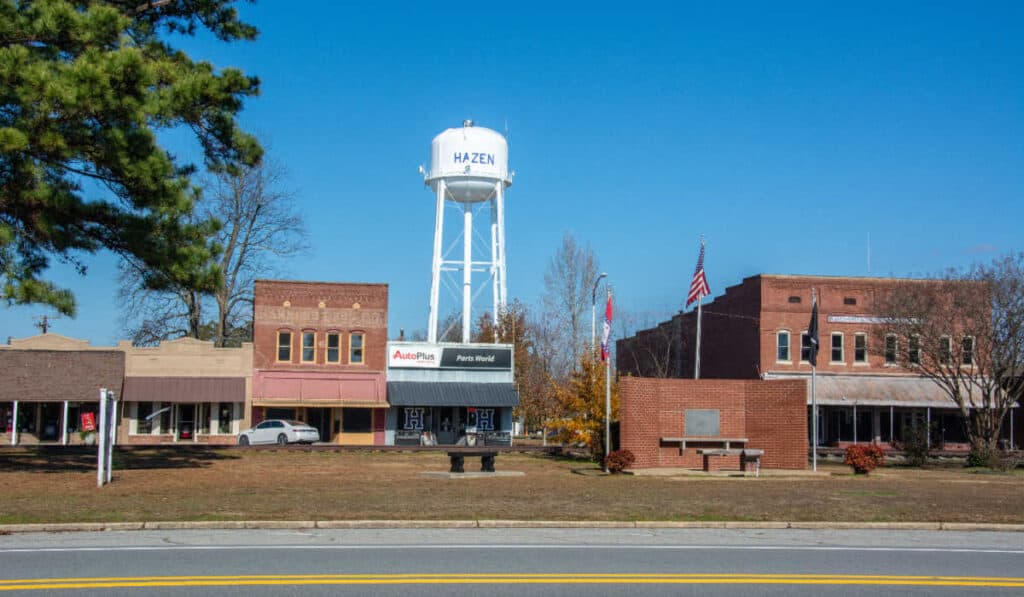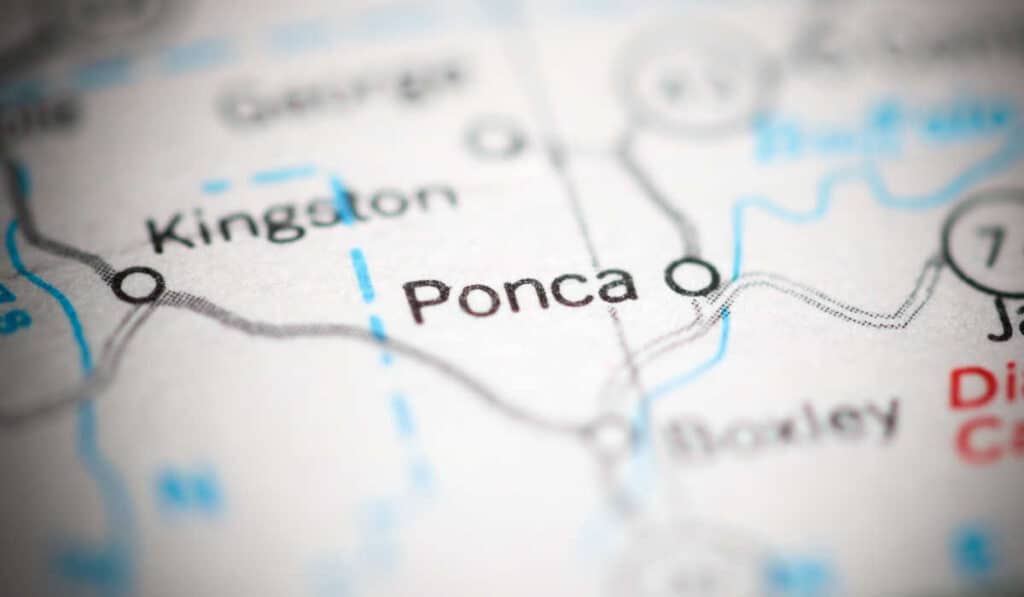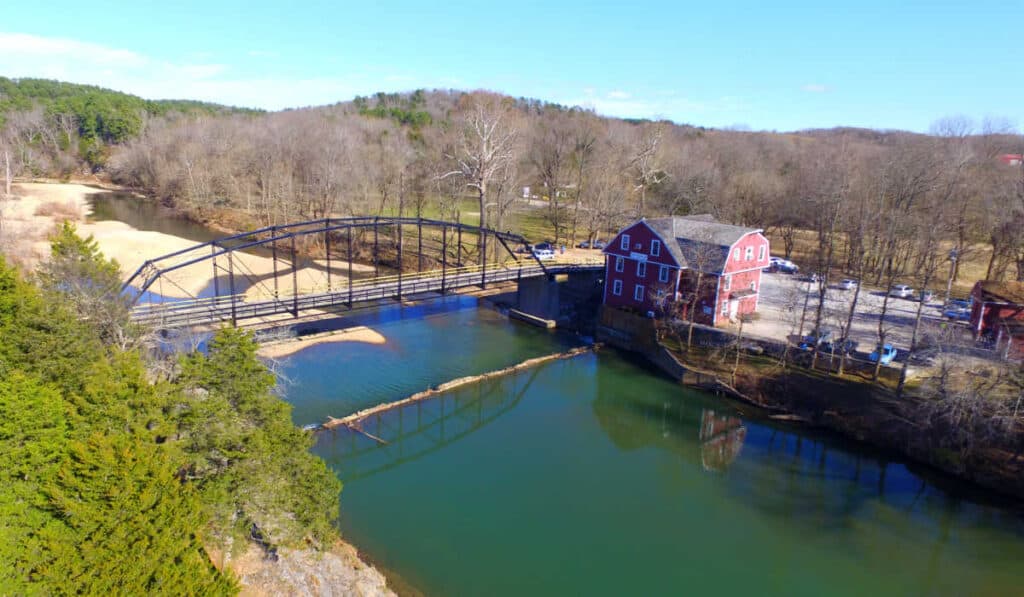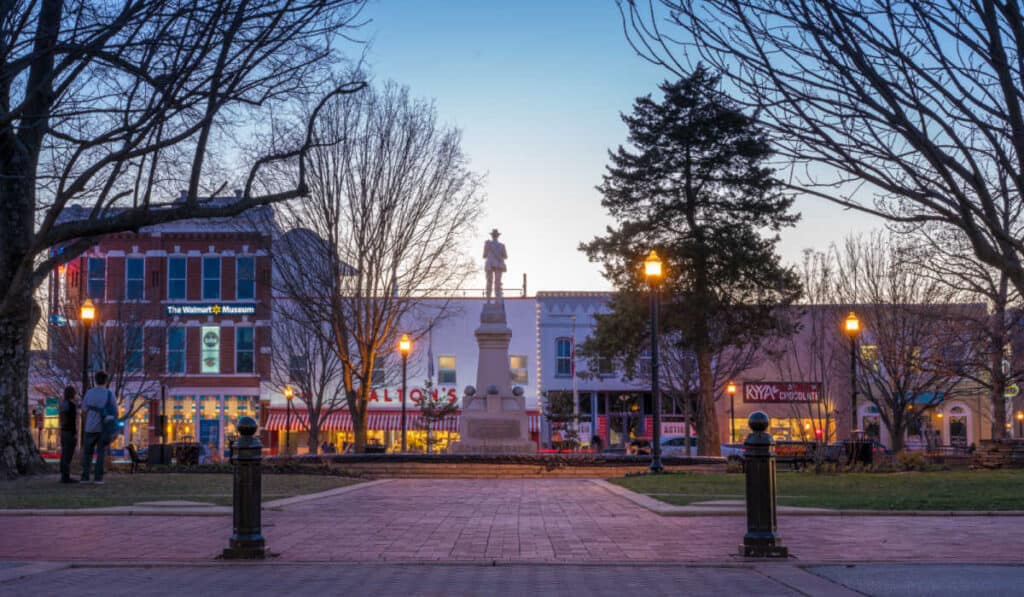What Is Fort Smith, Arkansas Known For?
Fort Smith, Arkansas is best known for its rich Wild West history. The city was an important frontier town and holds a crucial place in U.S. history as a gateway to the western frontier. Fort Smith National Historic Site, which includes the remains of the original 1817 fort and the “Hangin’ Judge” Parker’s 1886 courthouse, is a testament to its past. The city also features the U.S. Marshals Museum, further emphasizing its ties to frontier justice. Beyond history, Fort Smith is known for its thriving arts scene, which includes a yearly film festival, numerous art galleries, and colorful street murals. Additionally, the city’s proximity to the Ouachita Mountains and the Arkansas River allows for various outdoor recreational opportunities.
Fort Smith, Arkansas, situated on the Arkansas-Oklahoma state border, is a city rich in history and charm. Established in 1817 as a western frontier military post, Fort Smith quickly became a hub for fur trading. Nestled at the confluence of the Arkansas and Poteau rivers, the city’s strategic location has played a significant role in its storied past.
One of the most notable aspects of Fort Smith’s history is the establishment of the Fort Smith National Historic Site. This site commemorates nearly 80 years of history, including the realm of Judge Isaac C. Parker, who presided over the Federal Court for the Western District of Arkansas from 1875 to 1896. Known as the “hanging judge,” Parker’s legacy is one of the many intriguing facets of Fort Smith’s past. The city is also well-known for its vibrant downtown area, situated along the Arkansas River and featuring historical sites such as Miss Laura’s Visitor Center, which was once Miss Laura’s Social Club.
Today, Fort Smith has grown into a popular destination for history buffs, particularly Civil War enthusiasts, as well as travelers seeking unique experiences. With a wide variety of activities and attractions, the city continues to attract visitors eager to delve into its rich heritage and explore its many offerings.
Table of Contents
History
Fort Smith, Arkansas has a rich and significant history dating back to the early 19th century. The area was first acquired by the United States as part of the Louisiana Purchase in 1803, which involved the acquisition of a vast stretch of land west of the Mississippi River from France. In order to explore this new territory, the government sent the Pike Expedition in 1806 to investigate the areas along the Arkansas River.
The establishment of Fort Smith can be traced back to 1817 when it was founded as a military post at Belle Point. This strategic location provided a crucial point of connection between the eastern United States and the newly-acquired Indian Territory during the period of westward expansion. As a military post, the first Fort Smith served as a base for maintaining peace between the Osage tribe and newly arriving settlers.
During this time, the Indian Removal policies were enforced, leading to what is now known as the Trail of Tears. Native American tribes, including the Choctaw, Creek, and Cherokee, were forcibly removed from their lands in the southeastern United States and made to travel to designated Indian Territory, passing through Fort Smith. Many experienced immense hardship and loss of life during their journey.
In the mid-19th century, the construction of the second Fort Smith took place, as the original fort had fallen into disrepair. The new fort served as a supply depot and a base of operations for several military expeditions. It also played a vital role in facilitating westward expansion and served as a stop for the Butterfield Overland Mail route.
The Arkansas River that flows through Fort Smith has been crucial to the development and history of the region. The river not only served as a natural barrier during times of conflict but also enabled commerce and transportation that contributed significantly to the growth of Fort Smith.
Throughout its history, Fort Smith has played an essential role in the development and expansion of the United States and the Arkansas region. From its beginnings as a military post to its significant involvement in Indian Removal policies and the westward expansion, Fort Smith’s historical significance cannot be understated.
Fort Smith National Historic Site
The Fort Smith National Historic Site is a significant landmark in Fort Smith, Arkansas, known for preserving nearly 80 years of history. Established on December 25, 1817, its role was crucial in maintaining law and order during America’s westward expansion. The site encompasses 37 acres within the urban environment of Fort Smith and is listed on the National Register of Historic Places.
One of the prominent features of the historic site is the jail and gallows. As the frontier expanded, so did crime, and Fort Smith played a vital role in establishing law and order in the region. The jail in Fort Smith served as a holding facility for many outlaws, and the gallows were the site of numerous executions.
Another essential part of the site is the courtroom where Judge Isaac C. Parker, famously known as the “Hanging Judge”, presided over significant cases. Appointed in 1875, Judge Parker became a legendary figure for his strict enforcement of the law. Throughout his time on the bench, he sentenced many criminals to be executed by hanging, which contributed to his infamous moniker.
The Commissary Building, now restored, gives visitors an insight into the way the fort functioned in its heyday. This building served as a multi-purpose facility housing the jail, mess hall, offices, and sleeping quarters for soldiers. The exhibits within the building bring the past to life, giving you a glimpse of what life was like for those living and serving in Fort Smith.
Another notable historic site within Fort Smith is the Belle Grove Historic District, a 22-block area featuring various architectural styles, including Queen Anne, Italianate, and Victorian. The district is home to the Clayton House, a restored 19th-century residence showcasing the elegance and charm of southern living during the Victorian era.
Visiting the Fort Smith National Historic Site allows you to explore a rich tapestry of history, covering everything from the fort’s involvement in the Mexican War and Civil War to its connection to the Cherokee and other eastern tribes’ removal on the Trail of Tears National Historic Trail. As you walk through the grounds, pause along the way to reflect on the many events that unfolded here and the key figures that played such a significant role in defining the frontier.
Historical Figures
Fort Smith, Arkansas is known for its rich history and prominent historical figures who have contributed to shaping its legacy. One of the most notable individuals in the area’s past is Judge Isaac C. Parker, also known as the “hanging judge.” Parker presided over the Federal Court for the Western District of Arkansas at the Fort Smith National Historic Site. His tough stance on law and order made him a significant figure in the Wild West era, sentencing numerous outlaws to their deaths.
In addition to Isaac Parker, Major William Bradford played an essential role in Fort Smith’s history. As the founder of the first Fort Smith on December 25, 1817, Bradford’s leadership laid the groundwork for the establishment of this critical military post on the frontier, which provided protection from potential conflicts with the indigenous Choctaw tribe and other native communities in the area.
During the Civil War, Fort Smith became a critical battleground, with Union troops occupying the area at various points throughout the conflict. The fort changed hands multiple times, further emphasizing its military significance within Arkansas and the surrounding Indian Territory.
Another prominent historical figure connected to Fort Smith is William Henry Harrison Clayton, who worked as a prosecutor under Judge Isaac Parker. Known as W.H.H. Clayton, he was instrumental in maintaining law and order during the turbulent times of the Wild West, helping to bring outlaws to justice and playing a key role in implementing the rule of law in the region.
In summary, Fort Smith, Arkansas’ rich history is marked by significant historical figures such as Judge Isaac C. Parker, Major William Bradford, Union troops, and William Henry Harrison Clayton. These individuals have shaped the city’s legacy and contributed to its reputation as an important center of law and order during the Wild West era.
Military and Law Enforcement
Fort Smith, Arkansas, situated along the Arkansas River Valley at the junction of the Arkansas and Poteau Rivers, has a rich history in both military and law enforcement. Established as a western frontier military post on December 25, 1817, Fort Smith was initially tasked with maintaining peace between the Osage Nation and settlers moving into the area. The post later played an important role in the fur trading industry along the river.
During the Civil War, Fort Smith was occupied by both Confederate and Union soldiers, eventually falling under Union control. The city continued to develop as a base for migrants settling the “Wild West” and became well-known for its law enforcement heritage.
In 1872, the Western District of Arkansas was home to the Federal Court for the Western District, where Judge Isaac C. Parker presided. Parker was renowned for his stern stance on law and order, and he appointed over 200 deputies to enforce it. Sixty-five of these deputies lost their lives in the line of duty due to the dangerous nature of their work. The U.S. Marshals Service, which is the oldest federal law enforcement agency in the nation, was responsible for upholding the law within the Western District.
Fort Smith is also home to Fort Chaffee, which is located in Sebastian County. This military installation served as an Army training center and support base during World War II, the Korean War, and the Vietnam War. The city also shares a sister-city relationship with Cisterna, Italy, the site of the World War II Battle of Cisterna, where the United States Army Rangers were commanded by Fort Smith native William O. Darby.
Today, Fort Smith remains an important location in the realm of military and law enforcement, as it houses the Fort Smith National Historic Site, which preserves nearly 80 years of history spanning from the establishment of the first Fort Smith to the final days of Judge Parker’s jurisdiction over Indian Territory in 1896.
Culture and Attractions
Fort Smith, Arkansas is known for its rich history, culture, and attractions that make this city a unique destination. One of the most prominent places to visit is the Fort Smith Museum of History, which displays exhibits showcasing the city’s past with various artifacts and interactive displays.
Another notable attraction is the Clayton House, an Italianate-style mansion that offers a glimpse into the 19th-century life of an upper-class family. Here, visitors can explore the beautifully restored rooms and learn about the fascinating stories of the Clayton family.
A visit to Fort Smith wouldn’t be complete without a stroll down Garrison Avenue, the city’s historic main street. This revitalized area is home to numerous restaurants, bars, shops, and events throughout the year, reflecting the vibrant local community and its traditions.
Among other attractions, the Fort Smith Air Museum houses an extensive collection of aircraft and aviation-related artifacts. This museum is dedicated to preserving the history of aviation in Arkansas, providing a unique experience for aviation enthusiasts and history buffs alike.
The Fort Smith Trolley Museum offers a trip back in time with their historic streetcars, showcasing the city’s transportation legacy. Visitors can take a ride on one of these lovingly-restored trolleys and even witness the restoration process in the on-site workshop.
Another must-see destination is the United States Marshals Museum, dedicated to the history and stories of the nation’s oldest federal law enforcement agency. Exhibits here cover the Marshals’ role in shaping the American West, including the efforts of the famous “Hanging Judge,” Isaac C. Parker.
Lastly, the Chaffee Barbershop Museum provides a quirky glimpse into the past, as it is located in a fully restored barbershop that once served as the training facility on the now decommissioned Fort Chaffee Army Base. Here, visitors can learn about the history of barbering while appreciating the vintage equipment and memorabilia on display.
Fort Smith, Arkansas offers a diverse array of cultural experiences and attractions for visitors to appreciate. Whether delving into the city’s history, experiencing the local community’s vibrancy, or exploring unique museums, there is something for everyone to discover in this charming southern city.
Parks and Recreation
Fort Smith, Arkansas is known for its variety of parks and recreational activities that take advantage of the beautiful River Valley landscape. The city boasts numerous parks, including Fort Smith Park, Harley A. Wilson Park, and the Fort Smith National Historic Site, making it a popular destination for those who enjoy outdoor activities such as hiking, fishing, and canoeing.
The picturesque rivers and lakes in the area offer a wide range of opportunities for enthusiasts who enjoy spending time on the water. Whether it’s fishing in a serene lake or canoeing down the river, Fort Smith offers something for everyone. Additionally, the city’s extensive network of trails caters to hikers, joggers, and cyclists alike, providing exciting routes to explore the River Valley’s natural beauty.
Fort Smith’s recreational offerings extend beyond parks and nature. The city also hosts notable events such as the Fort Smith Riverfront Blues Fest and the Old Fort Days Rodeo. These events draw in large crowds, highlighting the vibrant local culture and fostering a strong sense of community.
Furthermore, the Fort Smith Convention Center serves as a versatile venue for various events, ranging from trade shows and conferences to concerts and performances. Its convenient location and modern facilities contribute to the city’s reputation as an attractive destination for work, play, and relaxation.
Population and Economy
Fort Smith, Arkansas is the third-most populous city in Arkansas, with a population of 90,452 as of 2023. The city is ethnically diverse, including individuals from various races, with Hispanics being a significant portion of the population.
Fort Smith is known for its manufacturing industry, which has played a vital role in the city’s economy. The diverse range of manufacturers in the area produce various consumer and industrial products, fueling economic growth. The city also hosts the Arkansas-Oklahoma State Fair, a popular event that showcases local businesses and attracts visitors from across the region.
The cost of living in Fort Smith is relatively low, with the median household income at $36,777 a year, compared to the US average of $53,482 a year. However, the average income of a Fort Smith resident is also lower, at $23,452 a year, compared to the US average of $28,555 a year.
Fort Smith is home to several shopping centers, including the Central Mall, which offers numerous retail options for residents and visitors alike. The city also has a variety of hospitals and medical centers to cater to the healthcare needs of its residents. Among them are Sparks Regional Medical Center, Mercy Hospital Fort Smith, and HealthSouth Rehabilitation Hospital, providing essential medical services to the community.
In summary, Fort Smith, Arkansas boasts a diverse population and a thriving manufacturing industry, balancing a low cost of living with an array of shopping and healthcare amenities.

